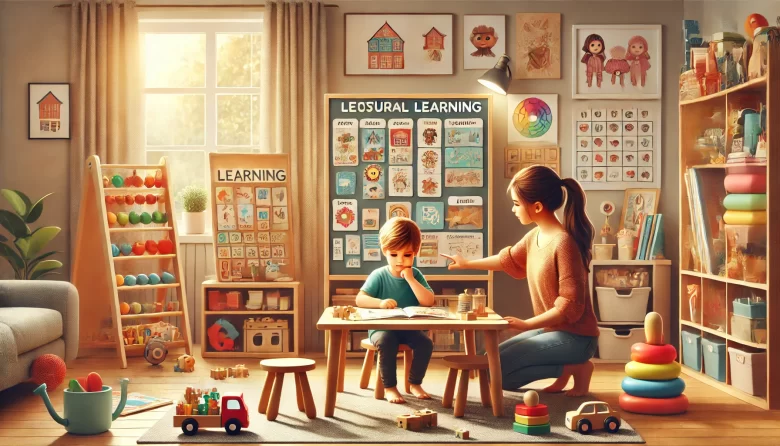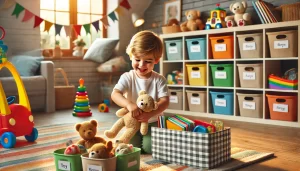Establishing a structured learning routine for young children is essential for their cognitive, emotional, and social development. A predictable routine helps kids feel secure, builds healthy learning habits, and improves their ability to focus and absorb new information.
However, creating an effective learning routine is about balance—it should be structured but flexible enough to adapt to a child’s interests, energy levels, and natural curiosity. In this guide, we’ll explore why a learning routine is important, how to set one up, and practical strategies to make learning engaging and effective at home.
Why Is a Learning Routine Important?
A well-structured routine provides several benefits for young children:
✔ Boosts Brain Development – Repetition strengthens neural connections, making learning more efficient.
✔ Improves Focus and Attention – Knowing what to expect helps children stay engaged longer.
✔ Reduces Anxiety and Stress – Predictability provides security, especially for toddlers and preschoolers.
✔ Encourages Independence – Kids learn to manage their own tasks and develop self-discipline.
✔ Promotes a Love for Learning – When routines include fun, engaging activities, children become excited about discovery.
The key is to create a structured yet flexible schedule that works for your child’s age and learning style.
How to Structure a Learning Routine for Young Children
A learning routine should include a mix of structured activities and free play to promote well-rounded development. Here’s how to set up an effective routine:
Step 1: Set Fixed Learning Blocks
Children thrive on routine, so aim for consistent learning periods each day. These should be short but effective:
🕘 Morning Learning (9:00 – 10:00 AM): Activities like reading, puzzles, and counting games.
🕛 Creative Time (12:00 – 1:00 PM): Art, crafts, or storytelling.
🕒 Afternoon Exploration (3:00 – 4:00 PM): Outdoor play, science experiments, or hands-on learning.
The key is to prioritize shorter, high-quality learning sessions instead of long, structured periods that may overwhelm a young child.
Step 2: Keep Learning Sessions Short and Interactive
Young children have short attention spans, so learning should be broken into small, engaging activities.
Ages 2-3: 5-10 minutes per activity
Ages 4-5: 15-20 minutes per activity
Ages 6+: 25-30 minutes per activity
Example: Instead of a 45-minute “math lesson,” do:
- 10 minutes of counting with objects
- 10 minutes of a number matching game
- 10 minutes of a shape drawing activity
Short, varied activities keep kids engaged and excited about learning.
Step 3: Include a Mix of Learning Activities
Children learn in different ways, so it’s important to incorporate multiple learning methods into their routine.
Literacy Activities: Storytime, letter tracing, phonics songs
Math & Problem-Solving: Sorting games, counting objects, puzzles
Creativity & Fine Motor Skills: Drawing, painting, playdough activities
Physical Movement: Dance breaks, obstacle courses, nature walks
Science Exploration: Simple experiments, water play, sensory bins
Social & Emotional Learning: Pretend play, role-playing emotions, gratitude discussions
By balancing academic learning, creativity, and movement, children stay motivated and engaged.
Step 4: Designate a Learning Space at Home
Having a dedicated learning space helps children associate the area with focus and exploration.
✅ Choose a Quiet, Well-Lit Area – A corner with a small table, cushions, and books.
✅ Keep Learning Materials Accessible – Low shelves with books, puzzles, and craft supplies.
✅ Limit Distractions – Remove excess toys or electronics that might shift attention away from learning.
✅ Use Visual Aids – Posters, a simple daily schedule, and a whiteboard for drawing and writing.
A structured learning environment makes learning feel intentional and engaging.
Step 5: Use Visual Schedules to Reinforce Routine
Children thrive on visual cues, so using a daily schedule with pictures or icons helps them follow along.
Example of a Simple Visual Schedule:
Morning Routine – Brush teeth, eat breakfast
Learning Time – Reading, puzzles
Creative Play – Painting or drawing
Outdoor Play – Nature walk or sports
Rest Time – Nap or quiet reading
You can print or draw a visual schedule and allow children to check off activities as they complete them.
Making Learning Routines Fun and Engaging
A structured routine should still feel exciting and playful! Here are ways to make learning more interactive and enjoyable:
✔ Use Hands-On Learning: Activities like building with blocks, measuring ingredients, or using craft materials reinforce lessons better than worksheets.
✔ Incorporate Playful Challenges: Turn learning into a game—”Can we find 10 red objects in the house?”
✔ Follow the Child’s Interests: If they love dinosaurs, read books and count dinosaur figures together.
✔ Mix Indoor and Outdoor Learning: Science walks, scavenger hunts, and outdoor reading make learning dynamic.
✔ Encourage Independence: Let children choose their activities for part of the day to build confidence and decision-making skills.
The more engaging the learning experience, the more children will naturally look forward to it.
Adapting Learning Routines for Different Age Groups
Learning routines should be flexible based on a child’s age and developmental stage.
Ages 2-3: Focus on sensory play, simple counting, songs, and movement-based learning.
Ages 4-5: Introduce structured activities like tracing letters, storytelling, and simple science experiments.
Ages 6+: Encourage early independent learning, problem-solving tasks, and more advanced projects.
The goal is to build learning habits over time—starting with playful exploration and gradually adding more structure as children grow.
Overcoming Common Challenges in Learning Routines
“My child gets bored quickly.”
✔ Solution: Rotate activities regularly and let them choose from a list of options.
“They resist structured learning.”
✔ Solution: Make learning interactive—use games, pretend play, and storytelling.
“We struggle with consistency.”
✔ Solution: Keep it simple and realistic! Even 20-30 minutes of structured learning a day makes a difference.
“They prefer screens over hands-on activities.”
✔ Solution: Balance tech time with hands-on play—use educational apps alongside real-world activities.
Incorporating Mindfulness and Emotional Regulation into the Routine
Best for: Teaching focus, self-regulation, and emotional intelligence
A good learning routine should also help children develop emotional awareness and self-regulation skills. Mindfulness activities can be a simple yet powerful addition to the daily schedule.
Ways to Include Mindfulness in Learning:
Deep Breathing Exercises: Teach kids to take deep breaths when they feel frustrated or overwhelmed.
Sensory Play Breaks: Play with textured objects, water, or kinetic sand to help children calm down.
Emotion-Based Storytelling: Read books that focus on emotions and ask, “How do you think the character felt?”
Music and Movement: Use calming music for relaxation or upbeat songs for energy before learning sessions.
Teaching emotional regulation alongside academic skills helps children become more resilient, focused, and ready to learn.
How to Adjust Learning Routines for Different Learning Styles
Best for: Personalizing education to match a child’s strengths
Every child has a unique way of processing information. A one-size-fits-all learning routine may not work, so it’s important to adapt activities based on learning styles.
Identifying and Adapting to Learning Styles:
Visual Learners:
✔ Use picture books, flashcards, and drawing activities.
✔ Create visual schedules and charts.
Auditory Learners:
✔ Use songs, rhymes, and storytelling.
✔ Encourage them to repeat information out loud.
Kinesthetic Learners:
✔ Use hands-on activities like building, crafting, and role-playing.
✔ Incorporate movement into learning (e.g., jumping while counting).
By tailoring the routine to your child’s strengths, learning becomes more effective and enjoyable.
The Role of Play in a Learning Routine
Best for: Making learning feel natural and engaging
Play is one of the most effective ways young children learn! Incorporating play-based learning ensures children remain engaged, curious, and excited about education.
How to Integrate Play into Learning Routines:
Pretend Play: Playing “store” to practice counting money.
Puzzles and Games: Using board games for problem-solving and teamwork.
STEM Building Activities: Using LEGOs or recycled materials for creative construction challenges.
Interactive Storytelling: Acting out stories or making up their own narratives.
Play-based learning makes education feel less like a chore and more like an adventure.
How to Involve Parents and Siblings in the Learning Routine
Best for: Strengthening family bonds and reinforcing learning
When learning is a family activity, children feel more supported, engaged, and excited to participate.
Ways to Involve Family Members in Learning:
Siblings as Learning Buddies: Older siblings can read to younger ones or help with simple math games.
Parent-Child Reading Time: Setting aside 10-15 minutes daily for shared reading builds literacy skills.
Family Learning Challenges: Holding friendly competitions like “Who can count the most blue objects in the house?”
Real-World Learning: Cooking together to practice measurements or doing DIY science experiments as a family.
Learning becomes more meaningful and enjoyable when shared with loved ones.
Encouraging Self-Led Learning and Independence
Best for: Building confidence, decision-making skills, and curiosity
While structured learning is important, self-led learning empowers children to take control of their education.
How to Promote Independent Learning:
Create a Learning Choice Board: Offer different activities (e.g., “Would you like to do a puzzle or a drawing today?”).
Encourage Questions: Let children explore their interests through books, experiments, or research.
Provide Open-Ended Materials: Give them access to art supplies, building blocks, and science kits.
Let Them Set Goals: Ask, “What would you like to learn about this week?”
By fostering independence, children become more motivated, confident, and eager to learn.
Final Thoughts
A well-planned learning routine helps young children develop essential skills while keeping education exciting and playful. The key is to create a structured but flexible approach that blends academic learning, creativity, and movement.
Start with small, manageable learning sessions, use hands-on activities, and adapt the schedule to your child’s unique needs. With consistency and encouragement, your child will develop a love for learning that lasts a lifetime!




